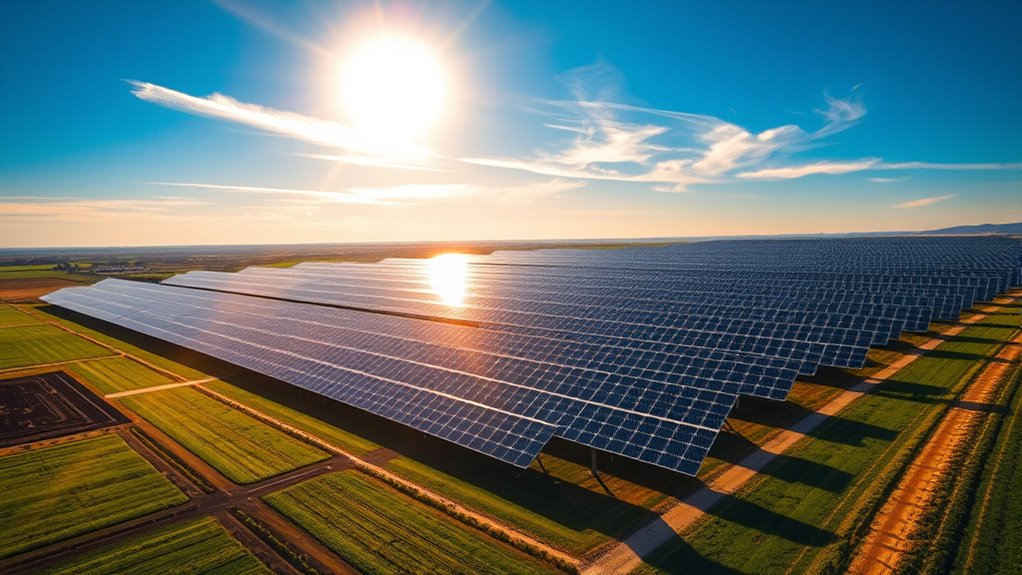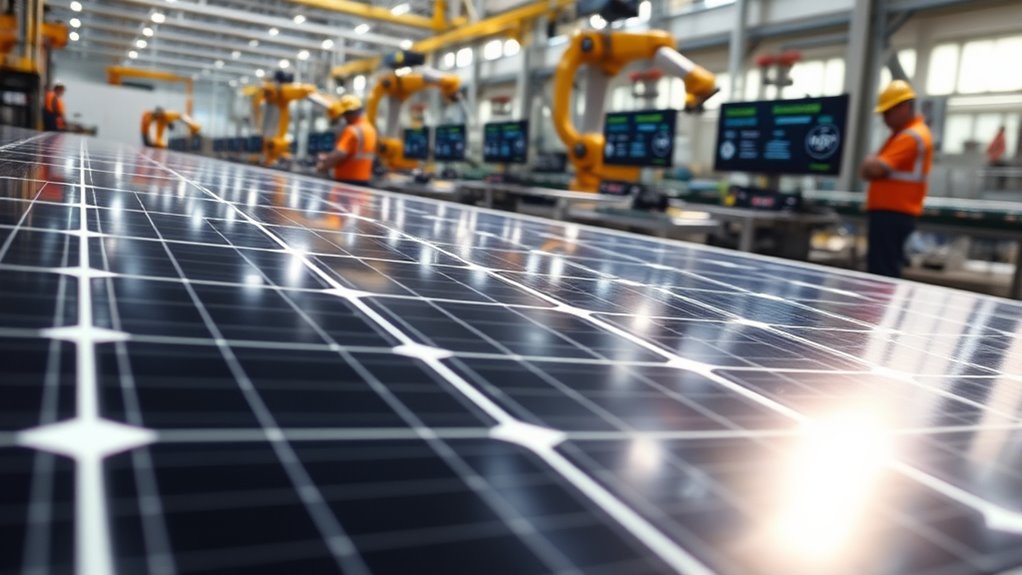Recent advancements in solar panel technology are transforming energy production. You'll find evolved solar cell materials like perovskite and organic designs that are lighter and more flexible. Efficiency rates have soared due to innovations like bifacial panels and multi-junction cells. Plus, smart technologies optimize energy use, enabling real-time monitoring and integration with home devices. Recycling techniques are also emerging to minimize waste. Keep exploring to discover how these advancements contribute to a brighter, sustainable future.
Key Takeaways
- New materials like perovskite and organic solar cells offer flexible designs and lighter installations on various surfaces.
- Multi-junction solar cells and improved coatings enhance energy conversion efficiency by capturing a broader spectrum of sunlight.
- Bifacial solar panels increase energy generation by utilizing sunlight from both sides and reflecting light in snowy or sandy environments.
- Smart technologies, including energy management systems and real-time monitoring, optimize solar energy usage and integrate with smart home devices.
- Innovations in solar panel recycling are minimizing waste and promoting sustainability through closed-loop systems for recovering valuable materials.
Evolution of Solar Cell Materials

As technology advances, solar cell materials have evolved significantly to improve efficiency and reduce costs. You might've noticed that traditional silicon cells are now just one option among many.
New materials like perovskite and organic solar cells are gaining traction, offering lighter, more flexible designs. These innovations allow you to install solar panels in a variety of locations, even on curved surfaces.
New materials like perovskite and organic solar cells enable flexible installations, even on curved surfaces, revolutionizing solar energy accessibility.
Plus, advancements in cell manufacturing processes mean you can get better performance at lower prices. By exploring options beyond conventional silicon, you're not only contributing to a greener planet but also benefiting from the latest in solar technology.
Embracing these materials can ultimately lead to more accessible and sustainable energy solutions for everyone.
Enhancements in Efficiency Rates

While many advancements in solar technology have focused on materials, enhancing efficiency rates remains a crucial goal. You'll find that researchers are constantly developing innovative methods to maximize energy conversion.
For instance, multi-junction solar cells can capture a broader spectrum of sunlight, significantly increasing efficiency. Moreover, improved anti-reflective coatings reduce energy loss from sunlight bouncing off the surface.
You may also notice that tracking systems, which adjust the panel's angle throughout the day, can boost energy capture by up to 40%. As these technologies evolve, you can expect solar panels to generate more electricity from the same amount of sunlight, making solar energy an even more viable option for your energy needs.
Embracing these advancements helps promote sustainable energy solutions.
Bifacial Solar Panels: A New Perspective

Bifacial solar panels represent an exciting evolution in solar technology, building on the advancements in efficiency rates we've discussed.
Unlike traditional panels, bifacial models capture sunlight from both sides, effectively harnessing reflected light from surfaces beneath them. This design boosts energy generation, allowing you to maximize the output from your solar installation.
When you install bifacial panels, you can benefit from enhanced durability and a longer lifespan, as they're typically made with robust materials that withstand the elements.
They're particularly effective in snowy or sandy environments, where reflection increases.
Integration of Smart Technologies

With the rise of smart technologies, homeowners can now optimize their solar energy systems like never before.
Smart inverters and energy management systems allow you to monitor and control your solar usage in real-time, maximizing efficiency. You can track energy production, consumption, and even store excess energy for later use.
Integration with smart home devices means your solar system can adjust automatically based on your energy needs, helping you save money on utility bills.
Additionally, apps give you insights into performance, enabling proactive maintenance.
By embracing these innovations, you're not just harnessing solar power; you're also enhancing your home's energy intelligence.
This integration makes solar energy more accessible and efficient, paving the way for a sustainable future.
Solar Panel Recycling Innovations

As solar energy systems grow in popularity, the need for effective recycling of solar panels becomes increasingly important. Innovative recycling techniques are emerging to tackle this challenge.
You might be surprised to learn that some companies are developing methods to recover valuable materials, like silicon, silver, and glass, from old panels. These processes not only minimize waste but also reduce the environmental impact of solar technology.
Some firms are even creating closed-loop systems, ensuring that recycled materials are reused in new panel production. By staying informed about these advancements, you can support eco-friendly practices in the solar industry.
Innovative companies are developing closed-loop systems to recycle materials, promoting sustainability in solar panel production.
Embracing these innovations helps promote sustainability and ensures a greener future for everyone involved in solar energy.
Cost Reduction Strategies in Manufacturing

While the solar industry continues to advance, manufacturers are constantly seeking cost reduction strategies to remain competitive.
You'll find that adopting automated production lines can significantly lower labor costs and minimize human error. Streamlining supply chains by sourcing materials locally also helps reduce transportation expenses.
Additionally, investing in research and development allows you to innovate processes that enhance efficiency and reduce waste. By utilizing advanced materials and technologies, you can cut production costs while maintaining quality.
Furthermore, collaborating with other companies in the industry can lead to shared resources and bulk purchasing discounts.
These strategies not only improve your bottom line but also contribute to a more sustainable and economically viable solar panel market.
Future Trends in Solar Energy Solutions

Emerging technologies are set to revolutionize solar energy solutions, making them more efficient and accessible than ever.
You'll see innovations like bifacial solar panels that capture sunlight on both sides, boosting energy production. Smart solar inverters will optimize energy use, adapting to your consumption patterns.
Plus, energy storage systems are becoming more affordable, allowing you to store excess energy for later use, enhancing your home's energy independence.
As building-integrated photovoltaics gain traction, solar cells will seamlessly blend into roofs and facades, making them visually appealing.
Moreover, advancements in perovskite technology promise higher efficiency at lower costs.
With these trends, you're looking at a future where solar energy isn't just an option, but a standard in sustainable living.
Frequently Asked Questions
How Do Solar Panels Perform in Extreme Weather Conditions?
Solar panels can face challenges in extreme weather conditions, but they're designed to withstand a range of climates.
In heavy snow, their surface can become covered, but the panels usually have enough heat to melt it off.
During heavy rain or storms, they're built to endure strong winds and impacts.
However, it's essential to ensure your installation is secure and regularly maintained, so you get the best performance regardless of the weather.
What Is the Lifespan of a Typical Solar Panel?
Imagine a steadfast guardian, standing tall against the elements. A typical solar panel's lifespan is around 25 to 30 years, though some can last even longer.
During this time, it captures sunlight like an artist painting a masterpiece. While efficiency may gradually decline, you'll still harness clean energy for years.
Regular maintenance helps you unlock its full potential, ensuring it continues to shine brightly, even as time marches on.
Can Solar Panels Work During Cloudy Days?
Yes, solar panels can still work during cloudy days.
While their efficiency may decrease due to reduced sunlight, they're designed to capture diffuse light, meaning they can generate electricity even when it's overcast.
You might notice a drop in power output, but you're still harnessing energy.
Are There Any Health Risks Associated With Solar Panels?
Are solar panels a hidden danger? Not really.
Most studies show that solar panels don't pose significant health risks. They're made primarily of silicon, which is safe for the environment and your health.
The real concern might be related to the production process, but once installed, they're harmless.
You can enjoy the benefits of renewable energy without worrying about negative health effects, making solar panels a smart choice for you and the planet.
How Do I Choose the Right Solar Panel for My Home?
When you're choosing the right solar panel for your home, consider your energy needs, budget, and the panel's efficiency ratings.
Research different brands and types, and look into warranties and customer reviews. It's also wise to check for local incentives or rebates.
Consulting with a solar energy professional can help you understand your options better.
Compare performance and costs to find the best fit for your specific situation and energy goals.
Conclusion
In a world where we're racing against climate change, it's ironic that the sun—our most abundant energy source—took us so long to harness effectively. With advancements in solar panel technology, you've got efficiency, smart integration, and even recycling innovations at your fingertips. So, while we're busy worrying about energy shortages, isn't it amusing that the solution has been shining down on us all along? Embracing these technologies might just be the brightest decision you make.









